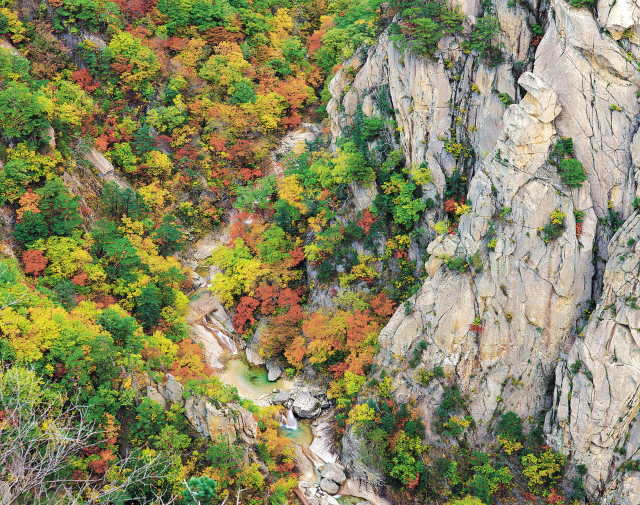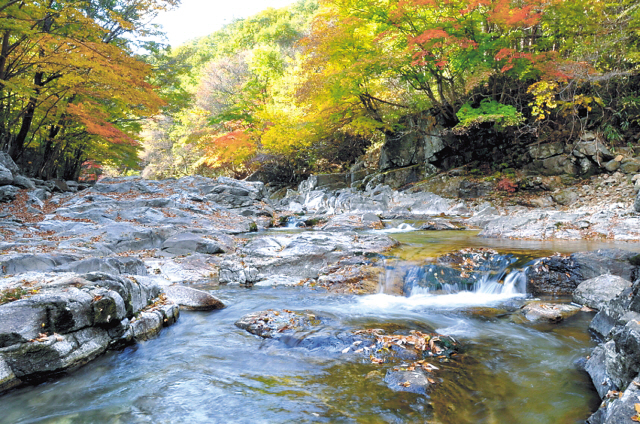From mountains to ancient cities, Korea becomes heaven for picnickersWhen autumn comes, picnickers get excited: It’s time to enjoy the changing foliage.
When mountains and fields in the country are filled with red and yellow leaves, Koreans pack their lunches and rush to nearby mountains or valleys to enjoy hiking, chatting, singing and socializing. Major roads to these tourist areas are jammed, toilets have long queues and beverage sales soar, thanks to people who want to enjoy the autumn colors for the day.
Some park their cars on quiet roads, take pictures, pick up their lunch and visit Buddhist temples at the foot of mountains. Others stop at local restaurants and enjoy water sports such as rafting and water skiing before they arrive at their destination.
“A foliage picnic is different from hiking or any sport,” says Kim Sang-hun, a 32-year-old office worker who calls himself a “Danpungnori (foliage picnic)-enthusiast.” “There’s no pressure to climb all the way to the top. You just enjoy the moment and watch the scenery ― that’s your ultimate goal,” he added.
Danpungnori has a long tradition here.
By the time of Goryeo Kingdom (918-1392), picnicking on “Junggujeol (double 9 day),” the ninth day of the ninth month of the lunar calendar, was a national pastime celebrating the doubling of the lucky odd number “9.” A book written in 1019 by celebrated author Jeong In-bo describes how the king held a bash for foreigners on the day.
In the Joseon era, Junggujeol became a national holiday when kings would encourage scholars to climb up to a higher place such as hillsides or mountains, drink chrysanthemum liquor and eat chrysanthemum pancakes for a day while enjoying foliage and composing poems. Even during the Japanese colonial rule (1910-1945) ordinary citizens were able to enjoy foliage picnics. Newspapers and the Japanese colonial government left records of the celebration.
“Seoulites loved Mount Nam, Bukhan, Dobong and others. People around the country loved to celebrate Junggujeol because it was the peak of foliage season and near or after the harvest season, which spared them time to take a break,” said Kim Tae-ho, researcher at the National Folk Museum.
This year, Junggujeol falls on Oct. 23 but the foliage will be spectacular even before and after the day, with a bit of a crisp chill in the air.
With the help of the Korea National Park Services, The Korea Herald presents some of the best places to enjoy the autumn foliage.

Mount Seorak (Korea National Park Services)
Mount Seorak in Gangwon Province is arguably the most visited mountain in the country. Its average temperature marks the lowest in South Korea, meaning that the peak foliage season comes the earliest in the country. Also, the temperature gap between the foot and the top of the mountain marks 12-13 degrees Celsius, resulting in a variety of colors.
Saturday is likely to see the fall foliage at its peak, according to the Korea Meteorological Administration.
One of the most followed trails for foliage picnics is the 6.2-kilometer path stretching from Heullimgol and Jujeongol to Osaek Yaksu. Osaek Yaksu’s mineral water contains more sodium than other ground water, which explains its unique flavor. Near the foot of the mountain, several restaurants serve dishes using the spring water.
Mount Bukhan
Mount Bukhan might be the most realistic and affordable choice for Seoulites as it is located in the northern part of Seoul. In 2009, the government allowed civilians’ access to Uiryeonggil, a path linking Mount Dobong and Mount Bukhan, some 40 years after it was shut down following an infiltration by North Korean agents.
Uiryeonggil is therefore known as one of the best-preserved trails in Seoul and the metropolitan area. An observatory at Obong (“five peaks”) is named after five men in an old folk tale who competed to win the heart of a beautiful lady there.
Those who wish to hike Uiryeonggil must make a reservation.
Mount Naejang
Mount Naejang has one of the best views in the country when it comes to autumn foliage.
Walking along the 6.5-kilometer Jangseongsaejaegil linking Namchang Exploration Center and Ipam Park Reservation Center will give people two hours of spectacular scenery.
Ipam Sanseong is one of the three most notable mountain fortresses in the Jeolla region. It is believed to have been built in the Samhan era (around B.C. 200) and now there are piles of rocks along the trail. Saeje Maeul (village) near the end of the trail has the moniker of Weoleunchi (“hidden moon”) after the woods that are so thick that they hide away the moon.
Naejang and Baekyang temples are at the foot the mountain, easy enough for children to visit. The peak of the foliage is expected on Nov. 6.

Mount Jiri
According to the Korea National Park Services, the best time to visit Mount Jiri that embraces South Gyeongsang Province as well as South and North Jeolla provinces is at the end of October.
One of the best routes on Jiri is the 3.2-kilometer path from Yukmojeong to Guryong Falls called Sorigil, or the path of sounds. There are nine cascades along the trail and a folktale has it that on the eighth day of the fourth month on the lunar calendar, nine dragons descend from the sky and enjoy bathing in the waters before ascending back to the sky.
The path is also famous as a place for artists of pansori, Korea’s traditional narrative music accompanied by a drum, to train their voices.
Gyeongju
If you are not a mountain lover, going to Gyeongju, the ancient capital of Silla (B.C. 57-A.D. 935), in North Gyeongsang Province is a good option.
The Sinmunwang Hoguk Haengchagil is the path that King Sinmun, the 31st king of Silla, is believed to have walked to commemorate his father, King Munmu, who is known to have ordered his son to bury his urn under a rock in the East Sea after his death.
In the ancient tale, King Sinmun met a dragon on the way from the commemoration ceremony and received jade along with a flute that could calm the seas and scare away any worries.
Things to remember
When on a picnic or in nature there are several things to bear in mind, said Kang Hong-kyu, a KNPS official.
“Please do not pick the vegetables. They are usually grown by local residents and even if they are not, it doesn’t mean that you can take them,” he said.
He also asked people to use the regular routes only.
“The regular routes developed by professionals are safe. But if you try ‘something unusual’ by sneaking into unauthorized routes you may encounter wildlife such as snakes or any accident could happen,” he said.
Cooking at national parks is strictly prohibited but there are designated camping sites in nearby parks.
Drinking alcohol is tolerated but smoking is prohibited.
By Bae Ji-sook (
baejisook@heraldcorp.com)


![[Exclusive] Korean military set to ban iPhones over 'security' concerns](http://res.heraldm.com/phpwas/restmb_idxmake.php?idx=645&simg=/content/image/2024/04/23/20240423050599_0.jpg&u=20240423183955)

![[Graphic News] 77% of young Koreans still financially dependent](http://res.heraldm.com/phpwas/restmb_idxmake.php?idx=645&simg=/content/image/2024/04/22/20240422050762_0.gif&u=)


